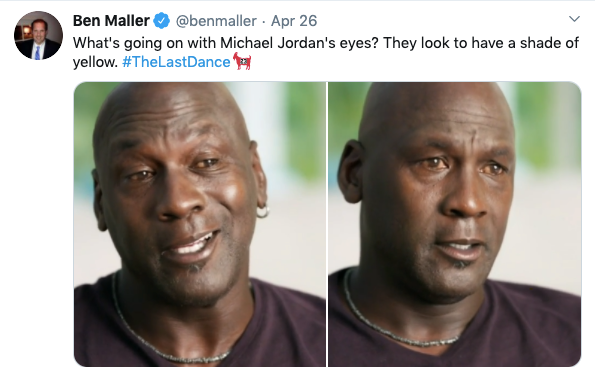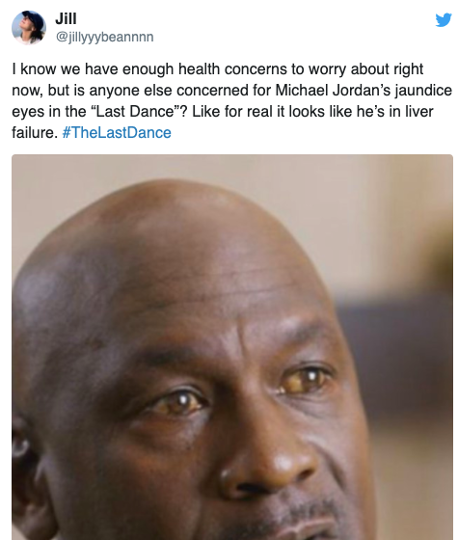
Michael Jordan, widely considered the most prolific basketball player of all time, has been seen recently lending his star power at various sporting events. But its his recent appearance at a September 2024 Champions League soccer match in Monaco that raised questions about his health. People particularly commented on the noticeable yellow tint in his eyes--a concern that that has been going on for years, but seems to be getting worse. Medical experts and fans alike have speculated that the yellowing may be a sign of jaundice, often linked to liver conditions like cirrhosis or hepatitis
When Did People First Notice His Yellow Eyes?
The first time people noticed it was during the highly-watched "The Last Dance." The Last Dance is in ESPN’s 30 for 30 documentary series, which goes deep into some of the most important moments in sports. In this particular documentary miniseries, ESPN follows the Chicago Bulls during their 1997-1998 season--the last season that the GOAT, Michael Jordan, played with the Bulls and the last time they won a championship.
The series features never-before-seen footage from that season and new in-depth interviews with Michael and a number of old teammates, players, coaches, and more. Besides being a riveting documentary about things you never knew were going on behind the scenes of an all-star team, many fans are commenting on how Michael Jordan looks now.
During the series, the camera cuts back and forth to present-day Jordan with one-on-one interviews. Besides the language, some fans can't get over how yellow Jordan's eyes look now.
The white of Jordan’s eyes, called the “sclera”, have turned yellow for the most part. They are clearly visible and the majority of his eyes are visibly yellowish leaving many to be concerned about the champion's health.
According to the American Academy of Ophthalmology, in the eyes of a normal patient, the sclera is white in color and the palpebral conjunctiva (the thin, clear tissue that covers the eye and lines the inside of your eyelid) appears pink. When a patient walks inside the Emergency Room and presents yellow eyes and nail beds, it may be automatically associated with liver or blood problems. But this is not always the case for folks that have a lot of melanin (aka "Black people").
The color of the sclera of Africans may range from yellow to muddy brown. This is normal and a benign condition commonly seen in our race and is often mistaken as jaundice.
Many mid- to dark-skinned races like Filipinos and African-Americans and some others, have large deposits of subconjunctival fat. This contains high levels of carotene that gives it a yellowish tint that often mimics jaundice. The fatty deposits grow to be denser as the distance from the cornea increases.


What Could Be Causing His Yellow Eyes?
Besides alcoholism, there is also a long list of conditions wherein jaundiced sclera can be found like:
Subconjunctival Hemorrhage
When the blood vessels around the conjunctiva break, blood leaks out and settles between the conjunctiva and the sclera. If the leak is small, a part of your eye may look a bit discolored, sometimes yellow or a little red.
A subconjunctival hemorrhage often appears as a bright red pool of blood in your eye. The condition usually causes no pain or vision changes, but occasionally causes minor itching of the eye. A scratchy sensation may sometimes be felt upon blinking. A subconjunctival hemorrhage, or eye bleed, can be caused by the following:
- Trauma
- Hard coughing
- Hard sneezing
- Vomiting
- Heavy lifting
- Forceful hand rubbing of the eye
- Constipation
- Various eye infections
Hyperbilirubinemia
Hyperbilirubinemia refers to increased levels of bilirubin. Bilirubin is produced when the liver breaks down old red blood cells. Bilirubin is then removed from the body through the stool (feces) and gives stool its normal brown color. When an abnormally high number of red blood cells is broken down, bilirubin can build up quickly in the body. Liver disease can also cause bilirubin levels to be abnormally high. Too much bilirubin is one cause of jaundice.
Leptospirosis
Leptospirosis is an infection caused by a bacteria called Leptospira genus. People with this infection often develop significant yellowing of the eyes. This infection shows up more in warmer climates and places where a person has exposure to water that has been contaminated by animal urine.
So what does this all mean?
Even though people on social media are speculating about Jordan's eyes, this doesn't mean anything is wrong. Jordan has never come out publicly about any health issues, but he has been very vocal with his words and his money in helping others.
Michael Jordan Opens Up his Own Family Medical Clinic
Not to be worried about his own health, Jordan is worried about the health of others. Jordan opened the Novant Health Michael Jordan Family Medical Clinic in his home state of North Carolina just five years ago.
An emotional Jordan unveiled the first of two medical clinics he and his family funded in Charlotte, N.C., that provides care to underprivileged members of the community.
The NBA Hall-of-Famer and Hornets owner was on hand for the grand opening of the $7 million Novant Health Michael Jordan Family Medical Clinic. Associated Press' Steve Reed reported that Jordan teared up when talking about the new $7 million family medical clinic project and said “this is just the beginning.”
“This is a very emotional thing for me to be able to give back to a community that has supported me over the years,” he continued.
The clinic, located in a lower-income section of the city, provides vital access to primary and preventive care to individuals in the community, including those who are uninsured or underinsured.
The 6,800-square-foot facility is equipped with 12 exam rooms, an X-ray room and a physical therapy space. In addition to that, a full-time social worker is on staff to provide social support services to patients.
Citizens will have access to social works, oral health practitioners, physical therapists and behavioral health experts in addition to primary health care services at the new clinic.

Numbers are well on their way of surpassing the projections that the clinics will provide care to at least 35,000 adults and children over the next five years.










